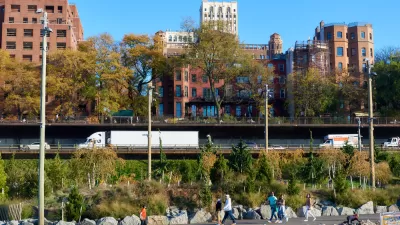The Brooklyn-Queens Expressway needs work, but the various proposals have very different visions about how to tackle the project and what the final outcome will be.

New York’s Brooklyn-Queens Expressway is up for major renovations, and the various proposals on the table could take it in one of a variety of directions. The triple-cantilever portion of the BQE supports the popular Brooklyn Heights Promenade, and the future of the pedestrian walkway is central in many of the debates around the expressway renovation plans.
The Department of Transportation is considering two proposals. The first plan would replace the promenade with a roadway for a period of time while construction work happens below. The second approach would shut down individual lanes, reroute traffic, and close the promenade for a shorter period of time. But the plans are contentious, reports Caroline Spivack:
Both proposals have their pros and cons, and both have garnered fierce opposition. Health experts have raised concerns about air pollution from erecting a highway practically on Brooklyn Heights residents’ doorstep. Preservationists, who say the project may violate decades-old laws that protect the promenade, have threatened legal action if the city moves forward.
Spivack reviews an array of other proposals for the BQE. The Brooklyn Heights Association has an alternative proposal to build a temporary bypass road parallel to the triple cantilever that would leave the promenade in place. City Council Speaker Corey Johnson is leading the charge for considering a teardown of the BQE, but critics say it is not realistic since trucks need access to the boroughs.
Comptroller Scott Stringer's idea for the BQE would not affect the promenade and would add a significant amount of park space. "His plan calls for converting the triple cantilever and the Cobble Hill trench—a depression of the BQE that runs from Congress Street to Hamilton Avenue—into a truck-only highway topped with a nearly two-mile-long 'linear park,'" writes Spivack.
The city has also considered proposals for a tunnel, but this plan is not likely to be pursued due to cost and logistics issues. "No matter what method is used to repair the expressway, one thing is certain: There are no painless solutions," Spivack concludes.
FULL STORY: Transform or tear down? The BQE reconstruction, explained

Maui's Vacation Rental Debate Turns Ugly
Verbal attacks, misinformation campaigns and fistfights plague a high-stakes debate to convert thousands of vacation rentals into long-term housing.

Planetizen Federal Action Tracker
A weekly monitor of how Trump’s orders and actions are impacting planners and planning in America.

In Urban Planning, AI Prompting Could be the New Design Thinking
Creativity has long been key to great urban design. What if we see AI as our new creative partner?

King County Supportive Housing Program Offers Hope for Unhoused Residents
The county is taking a ‘Housing First’ approach that prioritizes getting people into housing, then offering wraparound supportive services.

Researchers Use AI to Get Clearer Picture of US Housing
Analysts are using artificial intelligence to supercharge their research by allowing them to comb through data faster. Though these AI tools can be error prone, they save time and housing researchers are optimistic about the future.

Making Shared Micromobility More Inclusive
Cities and shared mobility system operators can do more to include people with disabilities in planning and operations, per a new report.
Urban Design for Planners 1: Software Tools
This six-course series explores essential urban design concepts using open source software and equips planners with the tools they need to participate fully in the urban design process.
Planning for Universal Design
Learn the tools for implementing Universal Design in planning regulations.
planning NEXT
Appalachian Highlands Housing Partners
Mpact (founded as Rail~Volution)
City of Camden Redevelopment Agency
City of Astoria
City of Portland
City of Laramie





























